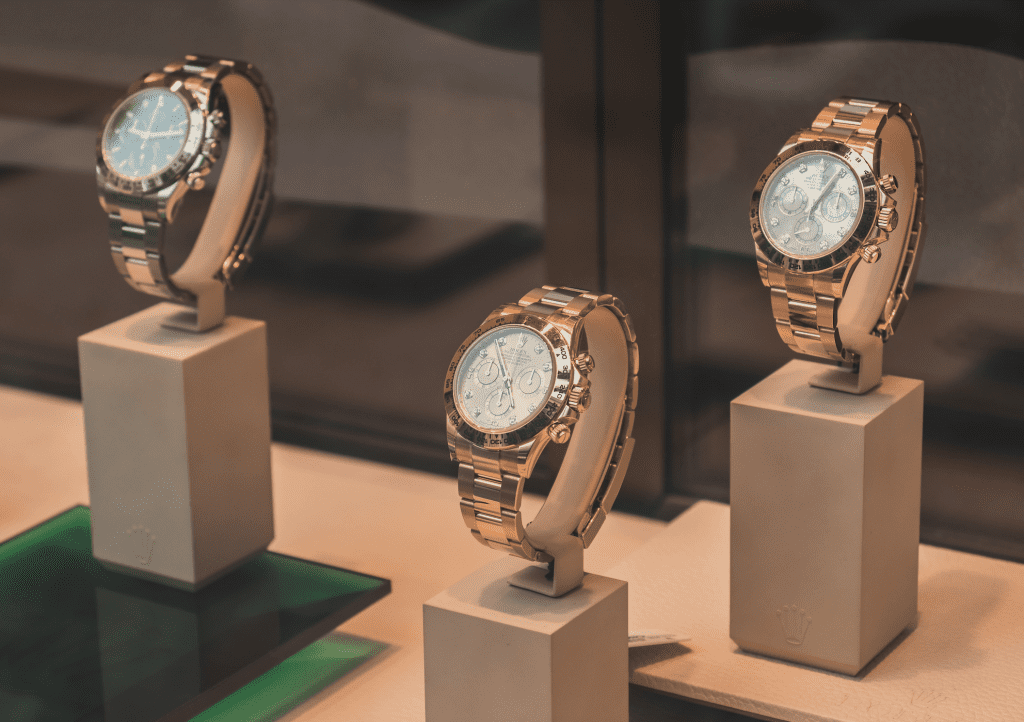Rolex has been dealt a loss in the latest round of its quest to block the registration of a crown-centric trademark with the European Union Intellectual Property Office (“EUIPO”), arguing that the mark is not only too similar to its well-known crown logo but is also likely to take unfair advantage of the reputation of the Rolex crown mark. In a decision on Wednesday, the EU General Court rejected Rolex’s opposition on both grounds, finding that the likelihood of confusion between the crown logo used on watches versus “clothing, footwear, headgear” – the latter of which are the goods listed on PWT A/S’s crown application – is low, and that there is no reputation in Rolex’s crown logo, on its own, that is at risk of being diminished.
The case got its start back in June 2016 when Rolex SA opposed the registration of Danish fashion group PWT A/S’s crown trademark for use on clothing, footwear, and headgear, pointing to the registrations issued to it by the EUIPO in 2001 for its crown logo, and the crown logo along with the word Rolex for use on “watches.” According to Rolex, the PWT A/S’s application should be blocked on the basis that the company was infringing Article 8(1)(b) of Regulation No. 207/2009 and Article 8(5) of that regulation.
Article 8(1)(b) of the EU Trade Mark Regulation states that a trademark application should be refused if: (1) the mark is similar to an earlier mark; (2) the goods/services are identical or similar; and (3) there is a likelihood of consumer confusion between the mark and previously-registered marks. Meanwhile, Article 8(5) states that an application can be refused if a previously-registered mark enjoys a reputation, and where, if used, the trademark applied for would be detrimental to – or take unfair advantage of – the distinctive character or repute of the earlier mark.

Following proceedings before the EUIPO, the Board of Appeal sided with PWT A/S, rejecting the existence of a likelihood of confusion due to the difference between watches, and clothing, footwear, and headgear. The Board similarly rejected Rolex’s reputation claim, finding that while Rolex maintains a notable reputation in its crown trademark when it is used in conjunction with the Rolex name, the crown on its own carries no such element of reputation with it, and thus, there is no risk of damage to Rolex if PWT’s mark is registered.
Likelihood of Confusion
The Swiss watchmaker appealed the Board’s determination, primarily arguing that the trademark body erred in finding that there was no similarity between the goods at issue “without taking into account their usual origin or the usual practices relating to their marketing.” Rolex further asserted that clothing and watches are similar – and thus, there is a greater likelihood of consumer confusion – because they “belong to market segments that are close to each other and that their purchase may be motivated by the search for aesthetic complementarity.”
Still yet, Rolex also claimed that thanks to the rise of e-commerce platforms, it is “common in the fashion sector for consumers to see clothes and accessories, such as glasses, jewelry and watches, being offered at the same points of sale.”
The General Court pushed back here, asserting that Rolex provided no evidence that spoke to the similarity of the goods at issue, and ultimately, determining that “the products in question are not competitive [goods].” It should be noted, according to the court, that “the fact that the goods in question may be sold in the same commercial establishments, such as department stores, is of no particular importance, since the products [offered up] are diverse in nature, without consumers automatically attributing them the same origin.”
As such, the court held that the Board of Appeal was right to find that the goods at issue are different and to reject the existence of a likelihood of confusion. Accordingly, Rolex’s arguments on this front must be rejected, the court stated.
Reputational Damage
Turning its attention to Rolex’s reputation-centric claims (which more-or-less mirror U.S. dilution claims), including its argument that the Board failed to consider that the use of the trademark that PWT applied for “would take unfair advantage of the distinctive character or reputation of [Rolex’s] marks … because of the immense reputation acquired by [those] marks,” the court affirmed the earlier determinations that Rolex failed to adequately allege how/why PWT’s mark would give rise to a “serious risk” of unfair advantage.
The arguments that Rolex did make – namely, “recalling that the Board of Appeal recognized the reputation of the [crown and Rolex name trademark] for wristwatches” and putting forward “a general consideration relating to the scale of the investments necessary to acquire a reputation” – do not make it “possible to establish the existence” of the elements required by Article 8(5).
The court stated that in order to benefit from the protection established by the provisions of Article 8(5), a trademark holder must show that: (1) the earlier mark (i.e., the mark with reputation)is registered in the relevant territory; (2) the earlier mark and the applied-for mark are either identical or similar; (3) the earlier mark must, in fact, have a reputation in the relevant territory and for the goods and/or services on which the opposition is based; and (4) use of the applied-for mark would take unfair advantage of – or be detrimental to – the distinctive character or reputation of the earlier mark.
Also worth noting in terms of reputation, which is the interesting aspect of the case, Jérôme Tassi, a partner at Paris-based firm AGIL’IT, says that the EUIPO previously determined that “there was no reputation on the [Rolex] crown [logo] alone,” stating that no evidence was provided to establish the crown maintains a reputation in the minds of consumers, whereas survey evidence revealed that the Rolex word mark “enjoys a reputation” in the EU.
Reflecting on Rolex’s claims, the court dismissed the opposition, thereby, paving the way for registration of PWT’s mark.
THE BIGGER PICTURE: Dilution-centric arguments are hardly a sure-fire win for luxury brands. You may recall that Chanel similarly lost a bid to block another party’s “lookalike” mark on Article 8(5) grounds not too long ago. The luxury brand was beaten by Chinese tech titan Huawei in an opposition proceeding in 2021, with a panel of judges for General Court stating that the Board of Appeal was correct in finding Chanel and Huawei’s marks were “dissimilar overall” and thus, the opposition had to be rejected on the basis of Article 8(5) and 8(1)(b).
Reflecting on the outcome at the time, Fieldfisher’s Amy Reynolds stated that the decision confirmed that “when assessing similarity of marks” – for the purposes of both Article 8(1)(b) and 8(5) – “only the protected version of those marks should be taken into account, [and] any hypothetical use, which may differ from the registration, is irrelevant when making the assessment.” She noted that in such situations, brands “may have a stronger case under the tort of passing off” in the United Kingdom, for instance, as “the court should be able to consider the commercial reality (such as goods bearing the logos being rotated in different directions) rather than being limited to the strict comparison of trademarks as filed/registered as required by the EUIPO.”
The case is Rolex SA v. European Union Intellectual Property Office (EUIPO), T‑726/21.














